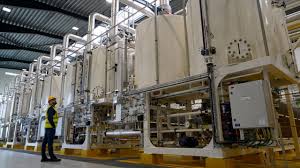News Flash
News Flash

FREDERICIA, Denmark, Nov 3, 2025 (BSS/AFP) - Denmark inaugurated one of
Europe's few low-carbon hydrogen plants on Monday, a sector touted as a key
to cleaner energy but plagued with challenges.
Using eight electrolysers powered by solar and wind energy, the HySynergy
project will produce around eight tonnes of hydrogen a day in its first
phase, to be transported to a nearby refinery and to Germany.
Hydrogen has been touted as a potential energy game-changer that could
decarbonise industry and heavy transport.
Unlike fossil fuels, which emit planet-warming carbon, hydrogen simply
produces water vapor when burned.
But producing so-called "green hydrogen" remains a challenge, and the sector
is still struggling to take off in Europe, with a multitude of projects
abandoned or delayed.
Originally scheduled to open in 2023, the HySynergy project, based in
Fredericia in western Denmark, has suffered from delays.
According to the International Energy Agency (IEA), only four plants
currently produce low-carbon hydrogen in Europe, none with a capacity greater
than one megawatt.
HySynergy will initially produce 20 megawatts, but "our ambitions grow far
beyond" that, said Jakob Korsgaard, founder and CEO of Everfuel, which owns
51 percent of the project.
"We have power connection, we have land, we have utilities starting to be
ready for expansions right here, up to 350 megawatts," he told AFP.
With the technology not yet fully mature, hydrogen often remains far too
expensive compared to the gas and oil it aims to replace, mainly due to the
cost of electricity required for its production.
Outside of China, which is leading the sector, the "slower-than-expected
deployment" is limiting the potential cost reductions from larger-scale
production, the IEA said in recent report.
It added that "only a small share of all announced projects are expected to
be operative by 2030."
"The growth of green hydrogen depends on the political momentum," Korsgaard
said, urging European Union countries and politicians to push for ambitious
implementation of the EU's so-called RED III renewable energy directive.
The directive sets a goal of at least 42.5-percent renewable energy in the
EU's gross final consumption by 2030, and highlights fuels such as low-carbon
hydrogen.